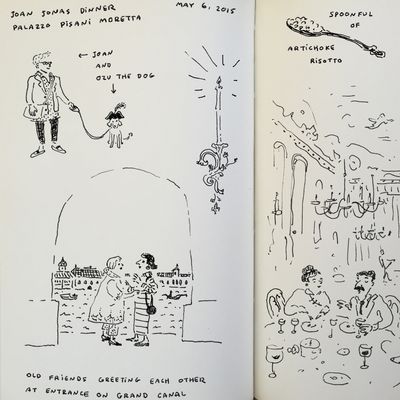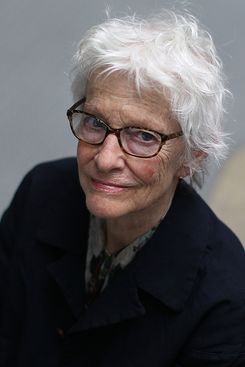
The vernissage of the Venice Biennale is this week, and the ancient city — normally overrun by tourists with selfie sticks and meandering gaits — is injected with a particular kind of glamour. During the day, it’s difficult to imagine a Venice without cruise ships docked at the harbor and the sound of suitcases on rolling wheels getting caught on the old stone streets. But by evening, the city softens as the sky turns opalescent like a Turner painting, and the art world steps out with an old-world sophistication that only a place such as this can hold with ease. Moneyed collectors sail around in water taxis, as the Bauer, the Guggenheim, plus all the various Palazzos and Fondaziones host outrageously elegant parties. The next morning, men with tote bags and women in Dries Van Noten and five-inch Prada heels roam the Giardini and the Arsenale, looking at all the art. I am here, too, having found myself floating in the delightful company of my friend Joana Avillez, illustrator extraordinaire, rolling deep with what I have affectionately begun to call the “Joan Jonas entourage.”

Jonas, 78, was chosen to be the representative for the American pavilion. In the way that the British pavilion representative this year, Sarah Lucas, says something of that country’s self-understanding, Jonas possesses elemental American characteristics. She is diminutive and unfussy, graceful but also practical, with cropped white hair and a strong jaw. Gathered with her is a collection of her friends, colleagues, and neighbors who have flown across the Atlantic, ready to celebrate. There is Charles Ruas, who is handsome and fond of cashmere scarves — “We call him the professor,” says Avillez, “because he has, like, two Ph.D.s.” There’s his husband, artist Rob Wynne, hilarious and emphatic, who, on my first night in town, announced that he wanted to buy velvet slippers and a hand-blown glass frog. Avillez’s mother, the artist and photographer Gwenn Thomas, is here as well; she’s known Jonas since they were young (she and Avillez are staying at a spartan converted nunnery). There’s editor Barbara MacAdam and writer Lilly Wei, too.
Also present is Ozu, Jonas’s winsome white poodle, whose supporting role in the artist’s work makes him quite popular at the fair (the video from a GoPro attached to his neck is not to be missed). He elicits smiles as we glide past tables and passersby like the sextuagenarian-friendly rat pack we are, with Ozu kicking up his paws as he’s walked on his red leather leash. “The Italians have started to call him Angelo,” Ruas said. “They hold up his ears and it looks like wings!”
Jonas has been in Venice for the last six weeks installing the pavilion for her work, which involves a medley of mediums that includes but isn’t limited to video, audio, hand-blown deckled mirrors, found objects such as masks and sand dollars, paintings, and sculpture. Yesterday afternoon, we arrived for a personal walk-through, and she explained the themes in the show: ghost stories, animal as metaphor, the ephemera of nature.
“It’s so Joan,” everyone murmured. “So Joan.”
Afterwards, we went with Jonas for lunch at a small restaurant outside of the Gardini. A no-nonsense waitress with an undershave, silver hoop earrings, and a Jane Birkin T-shirt took our order. She shouted at us in both English and Italian as she ran past carrying plates of food, her brusqueness endearing. “Yesterday she said a good one,” Jonas said, “She simply said, ‘HELLO, AMERICA!’” She nodded in approval. Conversation drifted around the show. “It’s just so beautiful and abstract,” said Wynne. They debated the virtues of apple-cider vinegar. “It makes you feel healthy,” says Wynne. “No, no, it is supposed to be good for the system,” Jonas replied. There had been a sighting of the art twins near San Marco, a true sign of an healthy art fair — the twins are at every one, dressed like Harajuku girls, in full costume and makeup, where they smile at you a little creepily.
“That’s a lot of work, to look like that,” said Avillez.
“Well,” Wynne paused to consider this, “That’s their job.”
In his 2007 novel Jeff in Venice, Death in Varanasi, Geoff Dyer writes about the social frenzy of Biennale: “This was it, the start of the Biennale proper: the onset of party-anxiety and invite-envy, the fear that there were better parties you’d not been invited to, a higher tier of pleasure that was forbidden to you. Once you got to Venice, this became still more acute. You could be at a tremendous party, full of fun people, surrounded by beautiful women, booze flowing, totally happy — but part of you would be in a state of torment because there was another party to which you’d not been invited.” And it’s true, I suppose, though what would Dyer say of Instagram? FOMO is our primary experience these days at a place like this, a social self eternally divided against itself. It’s too easy now to see what others are doing — Yvonne Force Villareal was fur-clad and drinking Dom Pérignon on a water taxi bound for somewhere fabulous, for example. Either way, after a couple of days in Venice, you realize how impossible it is to get anywhere quickly, anyhow.
But the night was Joan’s as far as we, in the entourage, were concerned. Jonas’s work has never received a major show at a major New York museum. And “They Come to Us Without a Word” is a success. The Times’ critic Roberta Smith tweeted on Tuesday: “National bias aside, pretty sure Joan Jonas’s US pavilion is a triumph. Mix of mediums extraordinaire.” So in the evening, we arrived at the Palazzo Pisani Moretta dressed up and ready to party. The damp dock acted as a Venetian red carpet as guests arrived in waves. Upstairs, Jonas posed with Ozu for the cameras, but only after fishing out a can of dog food to give to Thomas to feed him later in night (it’s apparently “incredible” here). Ozu sat underneath Thomas’s chair, as Avillez and I chatted with our tablemate, a Netherlander named Joeri (“My father was a communist who admired the figure skater,” he explained with Dutch flatness), who went on to inform us that he broke both his pinkies in two separate accidents. He held up his hands to show, and indeed, his fingers resembled L-shaped Tetris pieces. A young waiter with a voice like a castrato poured us wine, and the empty table behind us was quickly filled by a group of Italian men in suits who seemed to have nothing to do with the American pavilion. Artist Luigi Ontani floated by in a periwinkle linen suit. Architect Shigeru Ban shook hands with admirers. Glass chandeliers lit with candles hung overhead, the ceiling in Palazzo extravagantly painted. Nothing is too much in Italy — the curtains are lace, the staircase marble, the silver silver. Wynne overheard another guest say to her companion that the party was “so Joan,” which made the entourage laugh. “It looks like a wedding invitation!” Jonas remarked of the menus. “Can you taste the artichoke?” Thomas asked of the risotto. Even the tiramisu was sprinkled with too much cocoa. By the end of the evening, the candles along the Palazzo’s steps had been washed out by the canal. And Ozu had fallen asleep in Thomas’s lap, his chin resting on the rose-colored tablecloth.

